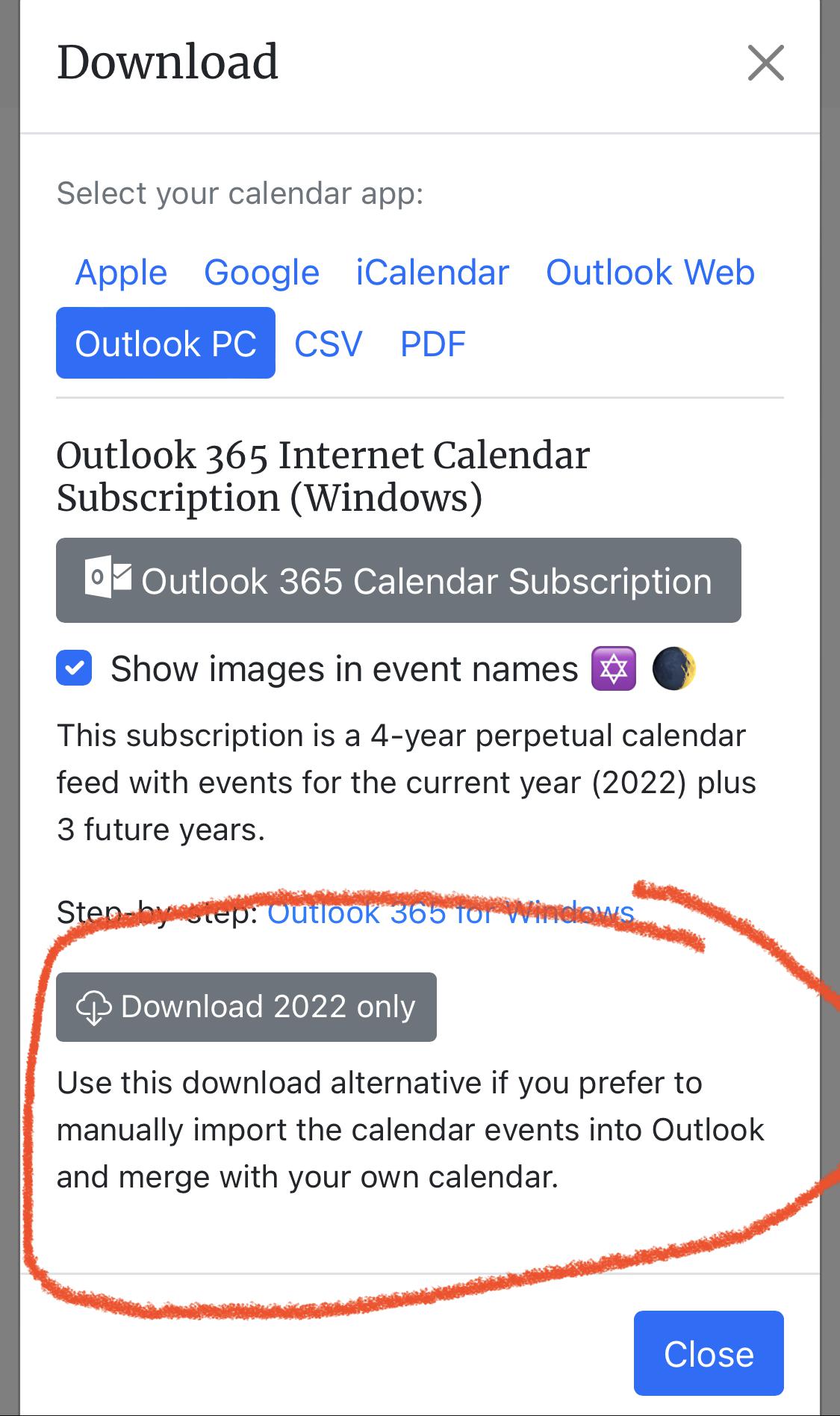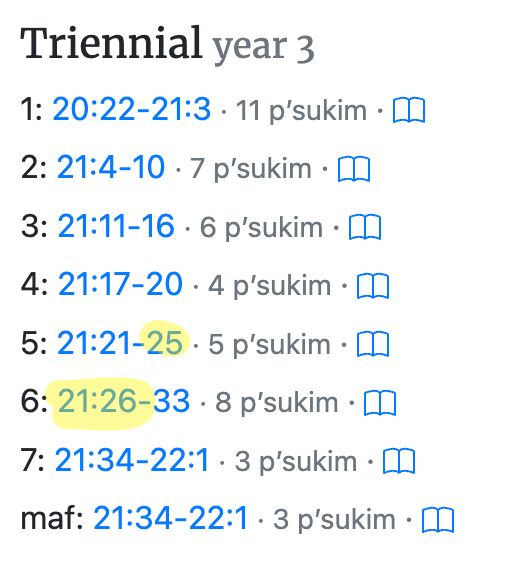
 outlook calendar merging
outlook calendar merging
Outlook calendar... I don't really want two calendars side-by-side, I want them merged.
Is there any way to merge them?

Hi, thanks for using Hebcal.
If you want to merge Hebcal events with your calendar you can click the smaller "Download 2022 only" button at the bottom of the dialog box like so:


Thanks for using Hebcal.
Hebcal Torah pages link to World ORT's Navigating the Bible II, a free online resource located at https://bible.ort.org/
Unfortunately, it looks like ORT's website is not working today. This may be a temporary issue.
You might consider trying an alternative, such as https://www.pockettorah.com/ (free) or https://troptrainer.com/ (not free, but very high quality).
Hebcal is not affiliated with World ORT or with TropeTrainer or PocketTorah.

 Slight error on Chukkat , July 9, 2022 reading 6
Slight error on Chukkat , July 9, 2022 reading 6
The 6th reading should be 21:26 - 21: 33 NOT 21:25 - 21:33.
Thank you.

Confirmed that this indeed was an error in the original 1988 CJLS triennial reading document. We've published the corrected reading on the hebcal.com website.


 Is third Triennial for Chukat inaccurate? Chamishi and Shishi both have 21:25
Is third Triennial for Chukat inaccurate? Chamishi and Shishi both have 21:25
It looks like Numbers 21:25 is listed twice in the triennial cycle; is this a mistake? I think so. Please advise.

Confirmed that this indeed was an error in the original 1988 CJLS triennial reading document. We've published the corrected reading on the hebcal.com website.


 Have Hebrew Date Appear on Top in Google Calendar (month view)
Have Hebrew Date Appear on Top in Google Calendar (month view)
I've downloaded Hebrew Calendar Dates en and he.
I'm successfully importing names and Yahrtzeit dates in CSV format from ShulCloud.
When I view the calendar, the hebrew dates for each day appear below the yahrtzeit names. I would like the hebrew date to appear at the top of each date
If I add an event time to each name, then the date does appear on top of the box. However the time is appearing in each box which clutters each day.
How can I have the hebrew date always appear on top?
We have a large shul and space on the calendar is important.
Thanks
Neil

Thanks for using Hebcal, and thanks for taking the time to post this message.
As I understand your post, you are looking to change the way Google Calendar formats events in the month view. You'd like the Hebcal daily Hebrew Dates to appear at the top of each day in the calendar month grid. Did I understand correctly?
Unfortunately, we do not have any way to influence how the Google Calendar month view works.
You might have better luck with Apple Calendar. In Apple Calendar, you can change the order of the calendars in the sidebar by dragging them up or down in the list. Calendars higher in the sidebar list will print closer to the top of each day in the month, week or day views. Calendars lower in the list will print closer to the bottom of each day.
We hope this helps!
If other readers have other suggestions, we'd love to hear them!

 Rosh Chodesh readings are missing
Rosh Chodesh readings are missing
Hi Michael,
It is my understanding that the Rosh Chodesh Tammuz Torah reading will be held on Wednesday 06/29/22 and Thursday 06/30/22.
However, since the Rosh Chodesh readings were removed from the weekday csv's - I don't see any reference to them on this website any longer.
Could you kindly prepare another csv that has all of the Rosh Chodesh readings?
A diaspora, Israel, and triennial version would be great.
below is the link to the Rosh Chodesh reading schemes for reference:
https://en.wikipedia.org/wiki/Yom_Tov_Torah_readings#Rosh_Chodesh
Rosh Chodesh
When Rosh Chodesh falls on a weekday, Numbers 28:1–15 is read. When Rosh Chodesh falls on Shabbat, Numbers 28:9–15 is read as the Maftir.
The individual readings are as follows:
Rosh Chodesh (weekday)[40]
Reading 1: Numbers 28:1–3
Reading 2: Numbers 28:3–5 (the third verse is re-read)[41]
Reading 3: Numbers 28:6–10
Reading 4: Numbers 28:11–15
Rosh Chodesh (Shabbat)[42]
Readings 1–7: Regular Torah reading
Maftir: Numbers 28:9–15
Haftarah: Isiah 66:1–24
Note: when Rosh Chodesh occurs on a Sunday, the regular Haftarah of the preceding day is replaced with the Machar Hachodesh (literally, "tomorrow is the new month") Haftarah, I Samuel 20:18–42.[43]
I have suggested this before - and I would like to suggest again that all the csv's be consolidated into a single csv for simplicity's sake. Now, if someone only wants to only see Shabbat readings - then you have a filter for Shabbat readings right inside the excel sheet. This makes simple sense to me and it would also lead to a full and comprehensive single document.

hi, thanks for using Hebcal. We implemented Rosh Chodesh Torah readings in our CSV downloads several months ago.
Please see this page
https://www.hebcal.com/sedrot/#download
And note this excerpt:
- The Full Kriyah CSV files contain Torah & Haftara readings for Shabbat, Rosh Chodesh, holidays and fast days.
- The Weekday CSV files contain Torah readings for Mondays & Thursdays (and Shabbat mincha) when those days don't co-occur with one of the events above. In other words, these files are intended to be mutually exclusive with the Full Kriyah Shabbat/holiday files.
If you download the fullkriyah-5782.csv file you will see the following starting at line 671:
29-Jun-22 Rosh Chodesh Tamuz 1 Numbers 28:1-28:3 3
29-Jun-22 Rosh Chodesh Tamuz 2 Numbers 28:3-28:5 3
29-Jun-22 Rosh Chodesh Tamuz 3 Numbers 28:6-28:10 5
29-Jun-22 Rosh Chodesh Tamuz 4 Numbers 28:11-28:15 5
30-Jun-22 Rosh Chodesh Tamuz 1 Numbers 28:1-28:3 3
30-Jun-22 Rosh Chodesh Tamuz 2 Numbers 28:3-28:5 3
30-Jun-22 Rosh Chodesh Tamuz 3 Numbers 28:6-28:10 5
30-Jun-22 Rosh Chodesh Tamuz 4 Numbers 28:11-28:15 5

 Jewish women Mikva Time .
Jewish women Mikva Time .
I am developing an App that helps the user keep track of the time of their mikva. is there any python lib or REST API I could use

Thanks for contacting Hebcal.
Sorry, I don't think we have any APIs that can help with this project.
Good luck!

 i need someone to develop the Jewish calendar to nokia feature phone . can someone recommend one ? liav
i need someone to develop the Jewish calendar to nokia feature phone . can someone recommend one ? liav
i want to implement the Jewish calendar in our nokia phones . need a mobile java developer . please recommend someone. liav ron +972523669780 liavr@hye.co.il liavron@gmail.com

Thanks for contacting Hebcal.
I am sorry but we lack the expertise to assist with your project. Good luck!

 no candle lighting
no candle lighting
Is there a way to create a calendar without the candle lightning and havdalah times?

Hi, thanks for using Hebcal!
If you'd like a calendar of only holidays (and no candle-lighting or havdalah times), you can visit this page and then be sure to delete the name of the city from the "Candle lighting times" input field

Hi, thanks for using Hebcal!
Our apologies that we don't yet offer an iPhone or Android app. We're working on an iPhone app that we hope to release before Rosh Hashana 5783. Stay tuned!
Customer support service by UserEcho



